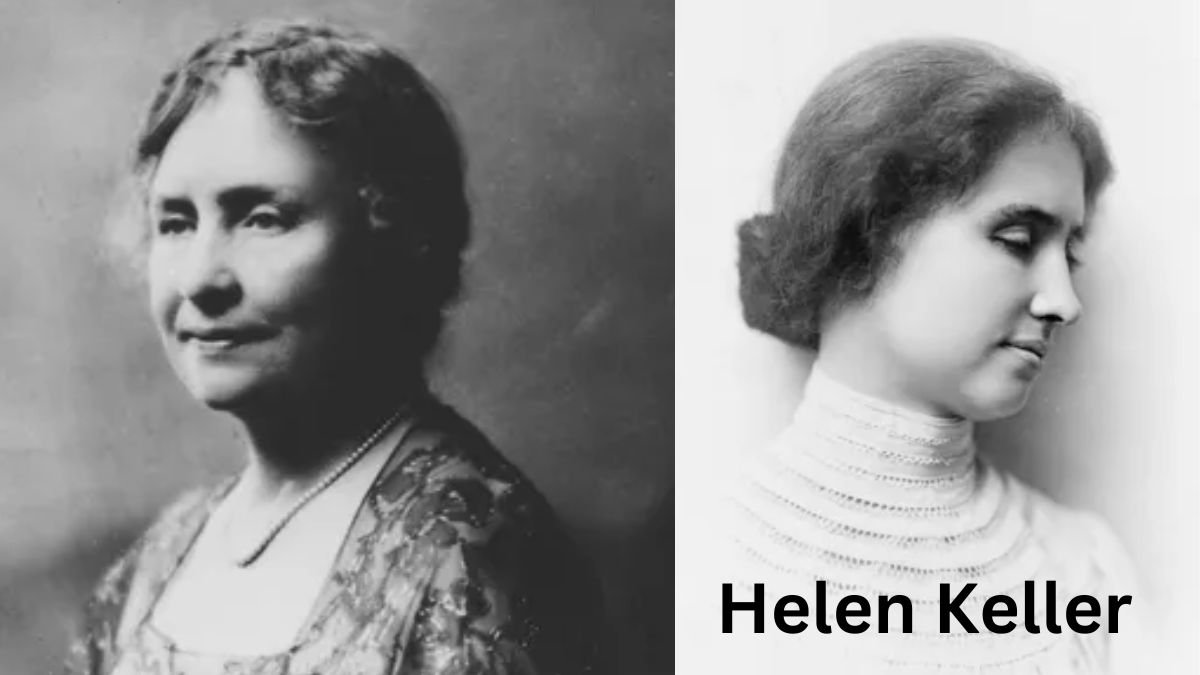Helen Keller, an iconic American author and educator, was born on June 27, 1880, in Tuscumbia, Alabama, USA. Her remarkable life, marked by profound accomplishments despite being blind and deaf, left an enduring legacy. She passed away on June 1, 1968, in Westport, Connecticut.

Helen Keller- Early Struggles and Educational Triumphs
At the age of 19 months, Keller faced a life-altering illness, possibly scarlet fever, which resulted in her being both blind and deaf. A pivotal moment occurred at the age of 6 when Alexander Graham Bell examined her condition. This examination led to a transformative connection with Anne Sullivan (Macy), a 20-year-old teacher from the Perkins Institution for the Blind in Boston, directed by Bell’s son-in-law. Sullivan, an extraordinary educator, remained by Keller’s side from March 1887 until her passing in October 1936.
Learning to Communicate
In a matter of months, Keller defied expectations by learning to feel objects and associate them with words through finger signals on her palm. She read sentences by feeling raised words on cardboard and crafted her sentences by arranging words in a frame. Her educational odyssey continued with winters at the Perkins Institution to learn Braille. Under the guidance of Sarah Fuller at the Horace Mann School for the Deaf, Keller embarked on the slow process of learning to speak.
Academic Pursuits and Achievements
Keller’s pursuit of education led her to enroll in the Wright-Humason School for the Deaf in New York City at age 14. At 16, she entered the Cambridge School for Young Ladies in Massachusetts. In 1900, she achieved a significant milestone by gaining admission to Radcliffe College, graduating cum laude in 1904.
Pioneering Writing on Blindness
Possessing unparalleled skills, Keller courageously addressed the taboo subject of blindness in women’s magazines. Edward W. Bok accepted her articles for the Ladies’ Home Journal, paving the way for publications in other major magazines such as The Century, McClure’s, and The Atlantic Monthly.
Literary Legacy and Advocacy
Keller chronicled her life in several influential books, including “The Story of My Life” (1903), “Optimism” (1903), “The World I Live In” (1908), “Light in My Darkness and My Religion” (1927), “Helen Keller’s Journal” (1938), and “The Open Door” (1957). In 1913, she embarked on a lecturing journey, supported by interpreters, primarily for the American Foundation for the Blind. Keller later established a $2 million endowment fund for the foundation.
Social Activism and Contributions
Keller’s impact extended beyond her achievements. In 1920, she co-founded the American Civil Liberties Union with civil rights activist Roger Nash Baldwin. Her efforts were instrumental in improving the treatment of the deaf and blind, leading to the removal of the disabled from asylums. Keller’s advocacy also prompted the establishment of commissions for the blind in 30 states by 1937.
Cultural Depiction and Recognition
The poignant story of Keller’s childhood training with Sullivan was immortalized in William Gibson’s play “The Miracle Worker” (1959), which earned the Pulitzer Prize in 1960. The subsequent film adaptation in 1962, featuring Anne Bancroft as Sullivan and Patty Duke as Keller, received two Academy Awards, further cementing Keller’s legacy in the hearts and minds of many.
FAQs
Q- Who was Helen Keller?
Ans- Helen Keller was an American author and educator who overcame being both blind and deaf. Born on June 27, 1880, in Tuscumbia, Alabama, she achieved remarkable success in education and advocacy.
Q- What were Helen Keller’s accomplishments?
Ans- Helen Keller achieved extraordinary accomplishments, overcoming her disabilities to learn Braille, speak, and graduate cum laude from Radcliffe College. She became a prolific author, lecturer, and advocate for the blind and deaf, co-founding the American Civil Liberties Union.
Q- What books did Helen Keller write?
Ans– Helen Keller authored several notable books, including “The Story of My Life” (1903), “Optimism” (1903), “The World I Live In” (1908), “Light in My Darkness and My Religion” (1927), “Helen Keller’s Journal” (1938), and “The Open Door” (1957).
Q- When did Helen Keller die?
Ans– Helen Keller passed away on June 1, 1968, in Westport, Connecticut.
Q- What was Helen Keller’s relationship with Anne Sullivan?
Ans– Anne Sullivan (Macy) was Helen Keller’s dedicated teacher, entering her life at the age of 20. Sullivan remained Keller’s teacher and companion from March 1887 until Sullivan’s death in October 1936.
Q- Why is Helen Keller important?
Ans- Helen Keller is important for her groundbreaking achievements in education and advocacy, defying societal expectations for individuals with disabilities. Her legacy inspires others to overcome challenges and promotes awareness and understanding of the deaf and blind communities.
Also Read
- William Shakespeare’s Wife; Shakespeare Biography, Early Life, Wife, Children, Poems, Plays, Precious Words Interesting Facts
- Elton John Net Worth: Biography, Age, Height, Family, Net Worth, and Retirement; Farewell Yellow Brick Road’ World Tour
- Olivia Rodrigo Biography, Career, Relationships, Net Worth, Awards Biography